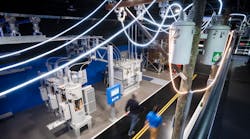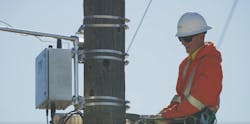Fortifying the electric grid against the threat of wildfires has never been more important. In 2020 alone, approximately 57,000 wildfires burned more than 10.3 million acres across the U.S.
Although wildfires are naturally occurring, utilities can strengthen distribution systems to reduce risk. The California Public Utilities Commission (CPUC) has significantly expanded its fire protection codes and standards, and utilities the world over are developing similar strategies and mitigation plans to reduce wildfire risk.
The reality is that updating transmission and distribution systems to combat wildfire risk is a complex effort. However, equipment manufacturers can help, specifically by designing and testing solutions with the California Department of Forestry and Fire Protection (CAL FIRE).
Understanding fire protection codes and standards
CAL FIRE regularly publishes the California Power Line Fire Prevention Field Guide. This document outlines procedures to minimize the risk of catastrophic wildfires caused by electrical power lines and equipment. The guide also details testing processes and a list of qualified equipment that meets exemption requirements.
For example, the guide provides Power Line Clearance Requirements for any organization that owns, controls, operates, or maintains any electrical transmission or distribution line upon any mountainous land, or in forest-covered land, brush-covered land, or grass-covered land. The guide states that these organizations should maintain the following distances of vegetation clearance from power lines:
a) Four feet away from any line operating at 2,400 or more volts, but less than 72,000 volts
b) Six feet away from any line operating at 72,000 or more volts, but less than 110,000 volts
c) Ten feet away from any line operating at 110,000 or more volts
Utilities may be able to achieve exemption from these types of requirements if they apply solutions approved to reduce wildfire risk. The exempted solutions are listed with their corresponding code exemptions within the field guide.
To obtain product exemption, manufacturers must follow strict test procedures demonstrating the ability to operate without generating sparks or arcs that would otherwise occur with traditional devices.
Testing guidelines for a CAL FIRE equipment exemption
CAL FIRE’s procedure for qualifying electrical equipment and devices for exemption is outlined in CCR Title 14, Section 1255. Under this section, the utility or hardware vendor must submit exemption requests to CAL FIRE with the following materials:
- A written request and pre-meeting invitation for temporary exemption
- Sample product
- Engineered product drawing and installation instructions
- Test results (including an infrared video recording)
- Electronic photographs and descriptions of equipment/devices tested
- Descriptions of testing procedures (i.e., American National Standards Institute Standard C37.40 – 1981)
- Professional third-party witness and verification
The last step for determining compliance must be conducted under the direction of a third-party electrical engineer or fire protection professional. All testing details such as current, voltage, and starting and ending times should also be recorded closely and included in the final documentation.
When performing the product exemption test, a radius of flammable vegetation is established around the device under simulated environmental conditions. The equipment is then installed according to manufacturer specifications and energized within its ratings.
The device is operated to ensure it does not cause ignition risk for the surrounding test material. For example, enclosed devices (like reclosers, sectionalizers, autotransformers, non-expulsion devices, etc.) need to demonstrate that no external arcs/sparks or expelled hot particles are generated during normal operation.
Similarly, open-type or fixed devices (such as air switches, open link fuses, connectors, lightning arresters, manual bypass switches and disconnects) need to interrupt line current and short-circuit current within the design range without creating arcs/sparks or hot particles.
Industry collaboration is critical for the future of wildfire prevention
It’s clear that combatting wildfires is a critical concern. CAL FIRE is leading the way to help utilities strengthen wildfire mitigation efforts with confidence. Although the organization’s guidelines may only apply to California utilities, I believe this framework is an extremely relevant template for utility risk management programs across North America.
To put it simply: Utilities need to be confident that their equipment will operate safely and efficiently over its service life. The testing guidelines for a product exemption in California provides just that.
Whether you’re in California and already meeting these requirements or anywhere else in the world, creating a more fortified electrical system should be a priority. The investment in site-ready fire-hardening technologies will not only help address wildfire risk — but also help better prepare the electrical grid for the demands of tomorrow.


